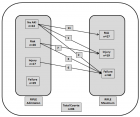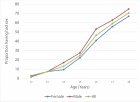Abstract
Review Article
Revisiting childhood pneumonia in low-recourse setting hospitals
Karimeldin MA Salih*
Published: 12 July, 2021 | Volume 4 - Issue 1 | Pages: 062-066
Introduction: Pneumonia, defined as infection of lung parenchyma, is associated with severe complications especially in the very young and old patients. It is the world’s leading cause of childhood mortality. The World Health Organization (WHO) classification and guidelines are commonly used in Sudan in the diagnosis and management of pneumonia patients. This review was the outcome of some researches done in Sudan by the author and his colleagues. Management Systems were evaluated to give complete end to end solutions for serving patients along with their records in hospitals and clinics in Sudan. The objective of the study was: To reflect author experience in management of childhood pneumonia in Sudan and to determine feasible, affordable approach to pneumonia in Sudan.
Methodology: Searching through PubMed for the author publication and review of publication by author in Sudan regarding management of pneumonia.
Conclusion: Simple tests like chest X-ray, high WBC high-reactive protein, together with high temperature can predict the need for urgent blood culture. Antibiotic treatment for childhood pneumonia weather that recommended by WHO, b-lactam inhibitors or 3rd generation cephalosporin has the same outcome.
Read Full Article HTML DOI: 10.29328/journal.japch.1001035 Cite this Article Read Full Article PDF
References
- World Health Organization. "Revised WHO classification and treatment of childhood pneumonia at health facilities." Geneva: World Health Organization. 2014; 6-14.
- World Health Organization. "Revised WHO Classification and Treatment of Childhood Pneumonia at Health Facilities–Evidence Summaries, 2014. Geneva: WHO. 2014.
- Levels and Trends in Child Mortality: Report 2014. United Nations Inter Agency Group for Child Mortality Estimation. UNICEF, WHO, The World Bank, United Nations Population Division. New York, 2014.
- Pediatric Pneumonia: Practice Essentials. Medscape. 2018.
- Childhood Pneumonia. JAMA Network. 2017.
- Great Ormond Street Hospital for Children. 2011.
- Pediatric Pneumonia: Etiology. Medscape. 2018.
- Boggs W. Point-of-Care Ultrasound Diagnoses Pneumonia in Children. Medscape Medical News. 2012.
- Bradley JS, Byington CL, Shah SS, Alverson B, Carter ER, et al. The Management of Community-Acquired Pneumonia in Infants and Children Older Than 3 Months of Age: Clinical Practice Guidelines by the Pediatric Infectious Diseases Society and the Infectious Diseases Society of America. Clin Infect Dis. 2011; 53(7):e25-76. PubMed: https://pubmed.ncbi.nlm.nih.gov/21880587/
- Pneumococcal Vaccination: What Everyone Should Know. Centers for Disease Control and Prevention. 2017.
- Salih KEM, Bilal JA, Alfadeel MA, Hamid Y, Eldouch W, et al. Poor adherence to the World Health Organization guidelines of treatment of severe pneumonia in children at Khartoum, Sudan. BMC Res Notes. 2014; 7: 531. PubMed: https://pubmed.ncbi.nlm.nih.gov/25123047/
- Country cooperation strategy for WHO and Sudan: 2008–2013. World Health Organization. Regional Office for the Eastern Mediterranean; 2010.
- O'Grady KAF, Taylor‐Thomson DM, Chang AB, Torzillo PJ, Morris PS, et al. Rates of radiologically confirmed pneumonia as defined by the World Health Organization in Northern Territory Indigenous children. Med J Aust. 2010; 192: 592-595. PubMed: https://pubmed.ncbi.nlm.nih.gov/20477736/
- Gove S. Integrated management of childhood illness by outpatient health workers: technical basis and overview. The WHO Working Group on Guidelines for Integrated Management of the Sick Child. Bull World Health Organ. 1997; 75(Suppl 1): 7-24. PubMed: https://pubmed.ncbi.nlm.nih.gov/9529714/
- Hopstaken R, Witbraad T, Van Engelshoven J, Dinant G. Inter-observer variation in the interpretation of chest radiographs for pneumonia in community-acquired lower respiratory tract infections. Clin Radiol. 2004; 59: 743-752. PubMed: https://pubmed.ncbi.nlm.nih.gov/15262550/
- Koster MJ, Broekhuizen BD, Minnaard MC, Balemans WA, Hopstaken RM, et al. Diagnostic properties of C-reactive protein for detecting pneumonia in children. Respir Med. 2013; 107: 1087-1093. PubMed: https://pubmed.ncbi.nlm.nih.gov/23672994/
- Díez‐Padrisa N, Bassat Q, Morais L, O’Callaghan‐Gordo C, Machevo S, et al. Procalcitonin and C‐reactive protein as predictors of blood culture positivity among hospitalised children with severe pneumonia in Mozambique. Tropical Med Int Health. 2012; 17: 1100-1107. PubMed: https://pubmed.ncbi.nlm.nih.gov/22809300/
- Michelow IC, Olsen K, Lozano J, Rollins NK, Duffy LB, et al. Epidemiology and clinical characteristics of community-acquired pneumonia in hospitalized children. Pediatrics. 2004; 113: 701-707. PubMed: https://pubmed.ncbi.nlm.nih.gov/15060215/
- Shah SS, Dugan MH, Bell LM, Grundmeier RW, Florin TA, et al. Blood cultures in the emergency department evaluation of childhood pneumonia. Pediatr Infect Dis J. 2011; 30: 475-479. PubMed: https://pubmed.ncbi.nlm.nih.gov/21206393/
- Díez-Padrisa N, Bassat Q, Machevo S, Quintó L, Morais L, et al. Procalcitonin and C-reactive protein for invasive bacterial pneumonia diagnosis among children in Mozambique, a malaria-endemic area. PloS One. 2010; 5: e13226. PubMed: https://pubmed.ncbi.nlm.nih.gov/20976241/
- Carrol ED, Mankhambo LA, Jeffers G, Parker D, Guiver M, et al. The diagnostic and prognostic accuracy of five markers of serious bacterial infection in Malawian children with signs of severe infection. PLoS One. 2009; 4: e6621. PubMed: https://pubmed.ncbi.nlm.nih.gov/19675669/
- Salih KMA, AliBilal J, Karsani AH. Risk factors of mortality among children admitted with severe pneumonia at a reference hospital in Khartoum, Sudan. Am J Med Medi Sci. 2015; 5: 130-134.
- Salih KM, El-Samani E, Bilal JL, Eldouch W, Ibrahim SA. Clinical and Laboratory Potential Predictors of Blood Culture Positivity in Under Five Children with Clinically Severe Pneumonia-Khartoum-Sudan. J Clin Diagnos Res. 2015; 9: SC04-7. PubMed: https://pubmed.ncbi.nlm.nih.gov/26436013/
- Programme of Acute Respiratory Infections. WHO Technical Advisory Group on Acute Respiratory Infections. Report of the Third Meeting, Geneva, 9-13 March 1987. Geneva: WHO; 1987. WHO/RSD/87.37). http://whqlibdoc
- Frayha H. The Management of Acute Respiratory Infections in Children: Practical Guidelines for Outpatient Care. King Faisal Specialist Hospital and Research Centre; 1997.
- Ribeiro CF, Ferrari GF, Fioretto JR. Antibiotic treatment schemes for very severe community-acquired pneumonia in children: a randomized clinical study. Rev Panam Salud Publica. 2011; 29: 444-450. PubMed: https://pubmed.ncbi.nlm.nih.gov/21829969/
- Salih KM, Bilal JA, Eldouch W, Abdin A. Assessment of treatment of community acquired severe pneumonia by two different antibiotics. J Clin Diagnos Res. 2016; 10: SC06-09. PubMed: https://www.ncbi.nlm.nih.gov/pmc/articles/PMC4948494/
- Ebeledike C, Ahmad T. Pediatric Pneumonia. StatPearls [Internet]: StatPearls Publishing; 2020. PubMed: https://pubmed.ncbi.nlm.nih.gov/30725625/
- Hall CB, Powell KR, Schnabel KC, Gala CL, Pincus PH. Risk of secondary bacterial infection in infants hospitalized with respiratory syncytial viral infection. J Pediatr. 1988; 113: 266-271. PubMed: https://pubmed.ncbi.nlm.nih.gov/3397789/
- McIntosh K. Community-acquired pneumonia in children. New Engl J Med. 2002; 346: 429-437. PubMed: https://pubmed.ncbi.nlm.nih.gov/11832532/
- Nohynek H, Valkeila E, Leinonen M, Eskola J. Erythrocyte sedimentation rate, white blood cell count and serum C-reactive protein in assessing etiologic diagnosis of acute lower respiratory infections in children. Pediat Infect Dis J. 1995; 14: 484-490. PubMed: https://pubmed.ncbi.nlm.nih.gov/7667052/
- Kapanadze N, Pantsulaia I, Chkhaidze I. Cytokines profile and its connection with disease severity in community-acquired pediatric pneumonia. Georgian Med News. 2018: 103-108. PubMed: https://pubmed.ncbi.nlm.nih.gov/30618399/
- Di Pietro P, Alberighi ODC, Silvestri M, Tosca MA, Ruocco A, et al. Monitoring adherence to guidelines of antibiotic use in pediatric pneumonia: the MAREA study. Italian J Pediatr. 2017; 43: 113. PubMed: https://pubmed.ncbi.nlm.nih.gov/29273072/
- Bose A, Coles CL, John H, Moses P, Raghupathy P, et al. Efficacy of zinc in the treatment of severe pneumonia in hospitalized children <2 y old. Am J Clin Nutr. 2006; 83: 1089-1096.
Similar Articles
-
Congenital poisoning after maternal parenteral mercury administrationBenjamin Courchia*,Leventer Roberts Maya,Meyer John,Galvez Maida,Herrera Jaime,Rauch Daniel. Congenital poisoning after maternal parenteral mercury administration. . 2018 doi: 10.29328/journal.japch.1001001; 1: 001-005
-
The Impact of Adenotonsillectomy on Health-Related Quality of Life in Paediatric PatientsShuaib Kayode Aremu*. The Impact of Adenotonsillectomy on Health-Related Quality of Life in Paediatric Patients. . 2018 doi: 10.29328/journal.japch.1001002; 1: 006-011
-
Severe Infantile Transaldolase deficiency: A case reportKhaled Alqoaer*,Ziad Asaad,Maisa Halabi. Severe Infantile Transaldolase deficiency: A case report. . 2019 doi: 10.29328/journal.japch.1001003; 2: 001-003
-
Prevalence of ESBL urinary tract infection in childrenKhalil Salameh*,Galia ZA Awean,Hala Elmohamed,Hoor Alshmayt,Mohamed Riad Bur Omer . Prevalence of ESBL urinary tract infection in children. . 2019 doi: 10.29328/journal.japch.1001004; 2: 004-007
-
Does it matter what a mother consumes? An anthropological exploration of dietary practices among Churachandpur (Manipur) pregnant women and its impact on infant birth weightJS Sehrawat*,Evelyn Ngaithianven,Reetinder Kaur. Does it matter what a mother consumes? An anthropological exploration of dietary practices among Churachandpur (Manipur) pregnant women and its impact on infant birth weight. . 2019 doi: 10.29328/journal.japch.1001005; 2: 008-014
-
Glycemic status and its effect in Neonatal Sepsis - A prospective study in a Tertiary Care Hospital in NepalBadri Kumar Gupta*,Binod Kumar Gupta,Amit Kumar Shrivastava,Pradeep Chetri. Glycemic status and its effect in Neonatal Sepsis - A prospective study in a Tertiary Care Hospital in Nepal. . 2019 doi: 10.29328/journal.japch.1001006; 2: 015-019
-
Branchio Oculo Facial SyndromeMaha Oudrhiri*,Toualouth L,Houda Oubejja,Fouad Ettayebi,Hicham Zerhouni. Branchio Oculo Facial Syndrome. . 2019 doi: 10.29328/journal.japch.1001007; 2: 020-020
-
Current childhood cancer survivor long-term follow-up practices in South AfricaAnel van Zyl*,Mariana Kruger,Paul C Rogers. Current childhood cancer survivor long-term follow-up practices in South Africa. . 2020 doi: 10.29328/journal.japch.1001008; 3: 001-007
-
Aripiprazole-induced seizures in children with autism spectrum disorder and epilepsyMohammed MS Jan*. Aripiprazole-induced seizures in children with autism spectrum disorder and epilepsy. . 2020 doi: 10.29328/journal.japch.1001009; 3: 008-010
-
Case-based education to improve learning and faculty teaching of residents and students in a clinical settingDiane E Lorant*,Elizabeth A Wetzel. Case-based education to improve learning and faculty teaching of residents and students in a clinical setting. . 2020 doi: 10.29328/journal.japch.1001010; 3: 011-015
Recently Viewed
-
Agriculture High-Quality Development and NutritionZhongsheng Guo*. Agriculture High-Quality Development and Nutrition. Arch Food Nutr Sci. 2024: doi: 10.29328/journal.afns.1001060; 8: 038-040
-
A Low-cost High-throughput Targeted Sequencing for the Accurate Detection of Respiratory Tract PathogenChangyan Ju, Chengbosen Zhou, Zhezhi Deng, Jingwei Gao, Weizhao Jiang, Hanbing Zeng, Haiwei Huang, Yongxiang Duan, David X Deng*. A Low-cost High-throughput Targeted Sequencing for the Accurate Detection of Respiratory Tract Pathogen. Int J Clin Virol. 2024: doi: 10.29328/journal.ijcv.1001056; 8: 001-007
-
A Comparative Study of Metoprolol and Amlodipine on Mortality, Disability and Complication in Acute StrokeJayantee Kalita*,Dhiraj Kumar,Nagendra B Gutti,Sandeep K Gupta,Anadi Mishra,Vivek Singh. A Comparative Study of Metoprolol and Amlodipine on Mortality, Disability and Complication in Acute Stroke. J Neurosci Neurol Disord. 2025: doi: 10.29328/journal.jnnd.1001108; 9: 039-045
-
Development of qualitative GC MS method for simultaneous identification of PM-CCM a modified illicit drugs preparation and its modern-day application in drug-facilitated crimesBhagat Singh*,Satish R Nailkar,Chetansen A Bhadkambekar,Suneel Prajapati,Sukhminder Kaur. Development of qualitative GC MS method for simultaneous identification of PM-CCM a modified illicit drugs preparation and its modern-day application in drug-facilitated crimes. J Forensic Sci Res. 2023: doi: 10.29328/journal.jfsr.1001043; 7: 004-010
-
A Gateway to Metal Resistance: Bacterial Response to Heavy Metal Toxicity in the Biological EnvironmentLoai Aljerf*,Nuha AlMasri. A Gateway to Metal Resistance: Bacterial Response to Heavy Metal Toxicity in the Biological Environment. Ann Adv Chem. 2018: doi: 10.29328/journal.aac.1001012; 2: 032-044
Most Viewed
-
Evaluation of Biostimulants Based on Recovered Protein Hydrolysates from Animal By-products as Plant Growth EnhancersH Pérez-Aguilar*, M Lacruz-Asaro, F Arán-Ais. Evaluation of Biostimulants Based on Recovered Protein Hydrolysates from Animal By-products as Plant Growth Enhancers. J Plant Sci Phytopathol. 2023 doi: 10.29328/journal.jpsp.1001104; 7: 042-047
-
Sinonasal Myxoma Extending into the Orbit in a 4-Year Old: A Case PresentationJulian A Purrinos*, Ramzi Younis. Sinonasal Myxoma Extending into the Orbit in a 4-Year Old: A Case Presentation. Arch Case Rep. 2024 doi: 10.29328/journal.acr.1001099; 8: 075-077
-
Feasibility study of magnetic sensing for detecting single-neuron action potentialsDenis Tonini,Kai Wu,Renata Saha,Jian-Ping Wang*. Feasibility study of magnetic sensing for detecting single-neuron action potentials. Ann Biomed Sci Eng. 2022 doi: 10.29328/journal.abse.1001018; 6: 019-029
-
Pediatric Dysgerminoma: Unveiling a Rare Ovarian TumorFaten Limaiem*, Khalil Saffar, Ahmed Halouani. Pediatric Dysgerminoma: Unveiling a Rare Ovarian Tumor. Arch Case Rep. 2024 doi: 10.29328/journal.acr.1001087; 8: 010-013
-
Physical activity can change the physiological and psychological circumstances during COVID-19 pandemic: A narrative reviewKhashayar Maroufi*. Physical activity can change the physiological and psychological circumstances during COVID-19 pandemic: A narrative review. J Sports Med Ther. 2021 doi: 10.29328/journal.jsmt.1001051; 6: 001-007

HSPI: We're glad you're here. Please click "create a new Query" if you are a new visitor to our website and need further information from us.
If you are already a member of our network and need to keep track of any developments regarding a question you have already submitted, click "take me to my Query."
















































































































































